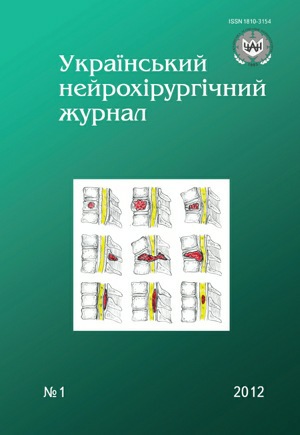Comparison of the spastic hand treatment methods
DOI:
https://doi.org/10.25305/unj.57748Keywords:
stroke, cerebral palsy, spastic hand, selective fasciculotomy, neurostimulation, stereotactic cryodentatectomy, rehabilitationAbstract
Background. The main goal of this research is to assess the efficacy of different surgical and conservative methods of spastic hand treatment, and to compare the efficacy of various surgical methods.
Methods. 56 patients underwent surgery and 40 received injections of botulotoxin A. Surgery included three methods: selective fasciculotomy of the median and ulnar nerve with or without stimulation of the radial nerve, as well as stereotactic cryodentatectomy. For conservative treatment purposes, botulotoxin A was injected in the muscles of the affected limb in a dose of 10–30 units per 1 kg of a patient’s weight depending on spastisity degree.
Results. Selective fasciculotomy with additional temporary stimulation of the radial nerve is the most efficacious approach that helps increase the force and function of the spastic hand. Isolated fasciculotomy and cryodentatectomy decreased spastisity significantly, but did not enhance the force and function of the spastic hand.
Conclusions. Botulotoxin A can be used at the initial stage of hand spastisity. In case of relapses surgery should be used to treat of the spastic hand, with selective fasciculotomy with temporary stimulation of the radial nerve being the most efficacious.
References
1. Keenan MA, Korchek JI, Botte MJ, Smith CW, Garland DE. Results of transfer of the flexor digitorum superficialis tendons to the flexor digitorum profundus tendons in adults with acquired spasticity of the hand. J Bone Joint Surg Am. 1987 Oct;69(8):1127-32. [PubMed]
2. Koman LA, Gelberman RH, Toby EB, Poehling GG. Cerebral palsy. Management of the upper extremity. Clin Orthop Relat Res. 1990 Apr;(253):62-74. [CrossRef] [PubMed]
3. House JH. Disorders of the thumb in cerebral palsy, stroke and tetraplegia. In: Strickland JW, editor. The thumb. Edinburgh: Churchill Livingstone; 1994. p.179-87.
4. Tsymbalyuk VI. Neyrokhirurgicheskoye lecheniye spastichnosti u bolnykh s ekstrapiramidnoy patologiyey [Neurosurgical treatment of spasticity in patients with extrapyramidal disorders] [dissertation]. Kiev (Ukraine): Neurosurgery Institute; 1995. Russian.
5. Lesov NS. Stereotaksicheskaya dentatotomiya v lechenii nekotorykh form spasticheskikh diskineziy [Stereotactic dentatotomiya in the treatment of some forms of spastic dyskinesia] [dissertation]. Moscow (Russia): Burdenko Neurosurgery Institute; 1978. Russian.
6. Chernyshov SN. Klinika i khirurgicheskoye lecheniye spasticheskoy krivoshei [Clinical and surgical treatment of spasmodic torticollis]. In: Sovremennyye voprosy funktsionalnoy neyrokhirurgii [Modern problems of functional neurosurgery]. Leningrad: Izd. LNKHI im. prof. A.L. Polenova; 1987. p.60-3. Russian.
7. Shershever AS. Neyrokhirurgicheskaya korrektsiya dvigatelnykh narusheniy u detey s detskim tserebralnym paralichom — sindromom farmakorezistetnoy epilepsii [Neurosurgical correction of motor disorders in children with cerebral palsy – pharmacoresistant epilepsy syndrome]. In: Abstract Book of the The 1st All Russia Congress “Sovremennyye tekhnologii v pediatrii i detskoy khirurgii” [“Modern technologies in pediatrics and pediatric surgery”]. Moscow; 2002. p.148.
8. Stepanenko AIu, Shabalov VA, Shevelev IN, Arkhipova NA, Artarian AA, Blinkov SM, Safronov VA, Lukianov VI. [The effect of selective dorsal rhizotomy on motor function in patients with infantile cerebral palsy]. Zh Vopr Neirokhir Im N N Burdenko. 1999 Oct-Dec;(4):14-8. Russian. [PubMed]
9. Albright AL, Tyler-Kabara EC. Combined ventral and dorsal rhizotomies for dystonic and spastic extremities. Report of six cases. J Neurosurg. 2007 Oct;107(4 Suppl):324-7. [CrossRef] [PubMed]
10. Albright AL, Gilmartin R, Swift D, Krach LE, Ivanhoe CB, McLaughlin JF. Long-term intrathecal baclofen therapy for severe spasticity of cerebral origin. J Neurosurg. 2003 Feb;98(2):291-5. [CrossRef] [PubMed]
11. Albright AL. Neurosurgical treatment of spasticity and other pediatric movement disorders. J Child Neurol. 2003 Sep;18 Suppl 1:S67-78. [PubMed]
12. Mertens P, Sindou M. [Microsurgical drezotomy for the treatment of spasticity of the lower limbs]. Neurochirurgie. 1998 Sep;44(3):209-18. . French. [PubMed]
13. Mertens P. Les neurotomie periferique dans le traitement de troubles spastiques des member [The peripheral neurotomy in treatment of spastic disorders]. Lyon: These Medicine; 1987. French.
14. Msaddi AK, Mazroue AR, Shahwan S, al Amri N, Dubayan N, Livingston D, Moutaery KR. Microsurgical selective peripheral neurotomy in the treatment of spasticity in cerebral-palsy children. Stereotact Funct Neurosurg. 1997;69(1-4 Pt 2):251-8. [CrossRef] [PubMed]
15. Pichkur LD. [Surgical tactics for spasticity of upper extremities in patients with infantile cerebral palsy]. Ukrainian Neurosurgical Journal. 2009(1):52-8. Ukrainian.
16. Maarrawi J, Mertens P, Luaute J, Vial C, Chardonnet N, Cosson M, Sindou M. Long-term functional results of selective peripheral neurotomy for the treatment of spastic upper limb: prospective study in 31 patients. J Neurosurg. 2006 Feb;104(2):215-25. [CrossRef] [PubMed]
17. Taira T, Hori T. [Selective peripheral neurotomy and selective dorsal rhizotomy]. Brain Nerve. 2008 Dec;60(12):1427-36. [PubMed]
18. Tsymbalyuk VI, Zozulya YuA. [Selective fasciculotomy and neurostimulation in spasticity hand treatment]. Ukrainian Neurosurgical Journal. 2011(1):60-3. Russian.
19. Tsymbalyuk VI, Zozulya YuA, Nikolaenko TO, Kaptelov VI, Sysenko IV. [Spastic hand treatment using botulinic toxin A and selective fasciculotomy]. Ukrainian Neurosurgical Journal. 2011(3):10-3. Ukrainian.
Downloads
Published
How to Cite
Issue
Section
License
Copyright (c) 2012 Yuriy Zozulya, Y. Tiagno, I. Bachurina, O. Konovalenko, V. Kirichenko, T. Mishina, D. Duka

This work is licensed under a Creative Commons Attribution 4.0 International License.
Ukrainian Neurosurgical Journal abides by the CREATIVE COMMONS copyright rights and permissions for open access journals.
Authors, who are published in this Journal, agree to the following conditions:
1. The authors reserve the right to authorship of the work and pass the first publication right of this work to the Journal under the terms of Creative Commons Attribution License, which allows others to freely distribute the published research with the obligatory reference to the authors of the original work and the first publication of the work in this Journal.
2. The authors have the right to conclude separate supplement agreements that relate to non-exclusive work distribution in the form of which it has been published by the Journal (for example, to upload the work to the online storage of the Journal or publish it as part of a monograph), provided that the reference to the first publication of the work in this Journal is included.









